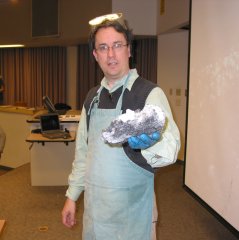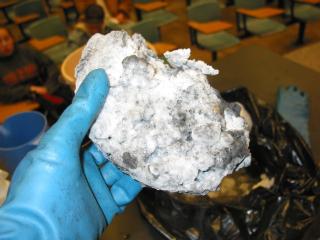

|
Astronomy 161:
An Introduction to Solar System Astronomy
Prof. Richard Pogge, MTWThF 9:30
|
Lecture 44:
Comets
Key Ideas:
Structure of Comets
- Nucleus & Coma
- Dust & Ion Tails
Nucleus is a "dirty snowball" of ices &
rock
Comets have long elliptical orbits
- Short- & Long-period comets.
- Origins in the Kuiper Belt & Oort cloud.
Comets
Comets are small bodies consisting of aggregates of ices mixed
with rock & dust.
As they approach the Sun, they heat up and the ices sublimate
(go from solid to gas):
- Gas & dust is swept back by solar radiation and the
solar wind into a spectacular luminous tails.
- Many faint comets are seen every year.
- A bright naked-eye comet appears only once every 10 years
or so.
Their sudden appearances have made them objects of wonder and
fear throughout human history.
Halley's Comet
In 1705, Edmund Halley computed the orbit of the great comet
of 1682 using Newton's laws for describing planetary orbits.
- He found that the orbit of the 1682 comet was the same as
that for comets seen in 1531 & 1607.
- On the basis of this, he predicted it would return again
in 1758.
It was seen again on Christmas day 1758, 12 years after
Halley's death.
Orbital properties:
- Elliptical orbit, e=0.967
- Semi-major axis, a=17.94 AU, with aphelion at 35 AU, and
perihelion at 0.6 AU.
- Period is 74-79 years.
Historical Appearances of Comet Halley
Comet Halley is one of the most observed comets in history.
The earliest recorded appearance is a Chinese observation of the
apparition of 240 BC.
It has been seen every 76 years or so since 240 BC:
- Recorded in Nuremberg Chronicle of 684 AD
- Appeared in April 1066, and was put into the Bayeux
Tapestry commemorating the Norman Conquest of England in
October 1066.
- Appears as the "Star of Bethlehem" in
Giotto's Adoration of the Magi (1301 apparition).
- Famous appearances in 1910 and 1986
- Next appearance is in 2062
Long- and Short-Period Orbits
Comet orbits naturally divide into two types:
Long-Period Comets: (P>200 years)
- Long elliptical orbits, some almost parabolic, not
confined to the ecliptic plane.
- About 700 known (e.g., Hale-Bopp)
Short-Period Comets: (P<200 years)
- Elliptical orbits close to the ecliptic plane.
- Abut 200 known (e.g., Halley)
Origin of Comets
The division of comets into long- and short-period comets
reflects their origins.
Short-period comets are from the Kuiper Belt:
- Reservoir of comets between 30 and 100 AU
- Knocked into the inner solar system by passing stars
- Perturbed into smaller orbits by Jupiter's gravity
Long-period comets are from the Oort Cloud:
- Ranges from 20,000 to 150,000 AU (about half-way to the
nearest star)
- May be ~500 Billion comet-sized objects in the Oort cloud.
- Total mass of all Oort Cloud comets combined may be
2-40 MEarth or more by some estimates.
- Only a few are perturbed by passing stars into the inner
solar system
Structure of Comets
Nucleus:
- Few km across, a dirty snowball of ices & dust
- Contains >99% the mass of the comet.
- Source of the gas & dust in the coma & tails.
Coma:
- Bright "head" of the comet.
- Low-density cloud of gas & dust sublimed off the
nucleus
- Extends out to 100,000 km or more.
Comet Tails
Comets have two tails:
Dust Tail:
- Composed of dusty particles swept back in a curved path
by solar radiation.
- Can be 1-10 Million km long
- Pale white in color from reflected sunlight
Ion Tail:
- Composed of ionized atoms & molecules swept straight
back by the solar wind.
- Can be up to 100 Million km long.
- Pale blue in color from emission lines of ions,
especially the CO+ ion
Properties of Halley's Nucleus
Small and irregular in shape:
- Size is 16 x 8 km
- Thought to be large for a comet nucleus
Low density:
- Mean density ~0.2 g/cc: porous ice & rock.
Very dark & cratered surface:
- Surface reflects only ~4% of incident sunlight
- Appears encrusted with carbonaceous dust
"Dirty Snowball" Model
The favored model for comet nuclei is the "icy
conglomerate" model of Whipple, usually called the
"dirty snowball model". In this model a comet nucleus
is an aggregate of:
- Water ice & CO2 ice (dry ice)
- Ammonia
- Dust & large chunks of rock
- Carbon & complex carbon compounds
The interior may be porous, giving it a density lower than
that of normal ices.
- This makes comets fragile and easily shattered by tidal
forces or breaking into pieces.
- We have seen comets that break apart or "calve"
as they pass around the Sun.
Why Study Comets
The comets are small, undifferentiated objects that are leftover icy
planetesimals from the formation of the Solar System.
Instead of having to travel out into deep space to study the icy bodies
of the outer Solar System, comets conveniently bring in material to us
as they pass by the Sun. Future space missions to comets will involve
chemical analysis and sample return.
Supplement:
Recent & Upcoming Spacecraft Visits to Comets
There were many more questions raised than answered by the
spacecraft that flew past Comet Halley in 1986. There are a
number of current and planned missions to study comets.
Of particular current interest are:
Stardust (US): Launched Feb 1999
- Flew past Comet Wild-2 in January 2004, will rendezvous with Earth
and should return a comet dust sample in mid-January 2006.
Deep Impact (US):
Launched 2005 January 12, Fly-by of Tempel 1 2005 July 4:
- Flew past Comet P/Tempel 1 on 2005 July 4th & launched a 370kg
impactor probe into the comet. Imagers on both spacecraft recorded the
successful impact, and instruments in space and on the ground recorded
image and spectra of the debris kicked out. This gave us our first good
look at the composition of the inside a comet by blasting material out
of the subsurface.
Rosetta (ESA):
Launched 2004 March 2
- Rendezvous with Comet P/Churyumov-Gerasimenko in 2014, go into
orbit, and land the Philae probe on its surface. Will also fly by 2
asteroids (21 Lutetia and 2867 Steins) enroute. The Philae lander
carries cameras, spectrometers, gas analyzers, radio and acoustic
sounding equipment to probe the comet interior, and a sample drill.
Comet Model
At the end of class, I constructed a simple model of a comet nucleus
using water, dry ice (frozen CO2), carbon, anhydrous ammonia
(a stand in for NH3), and silicaceous sand:

Comet Nucleus model, with the instructor. |

Comet Nucleus model close-up, showing the porous ice-matrix structure. |
- Photos by Katie Schlesinger - click on the thumbnail to view full size.
Readings in Universe: Chapter 17,
Section 17-7 through 17-9
Return to [
Unit 6 Index
|
Astronomy 161 Main Page
]
Updated: 2006 November 29
Copyright © Richard W. Pogge,
All Rights Reserved.

